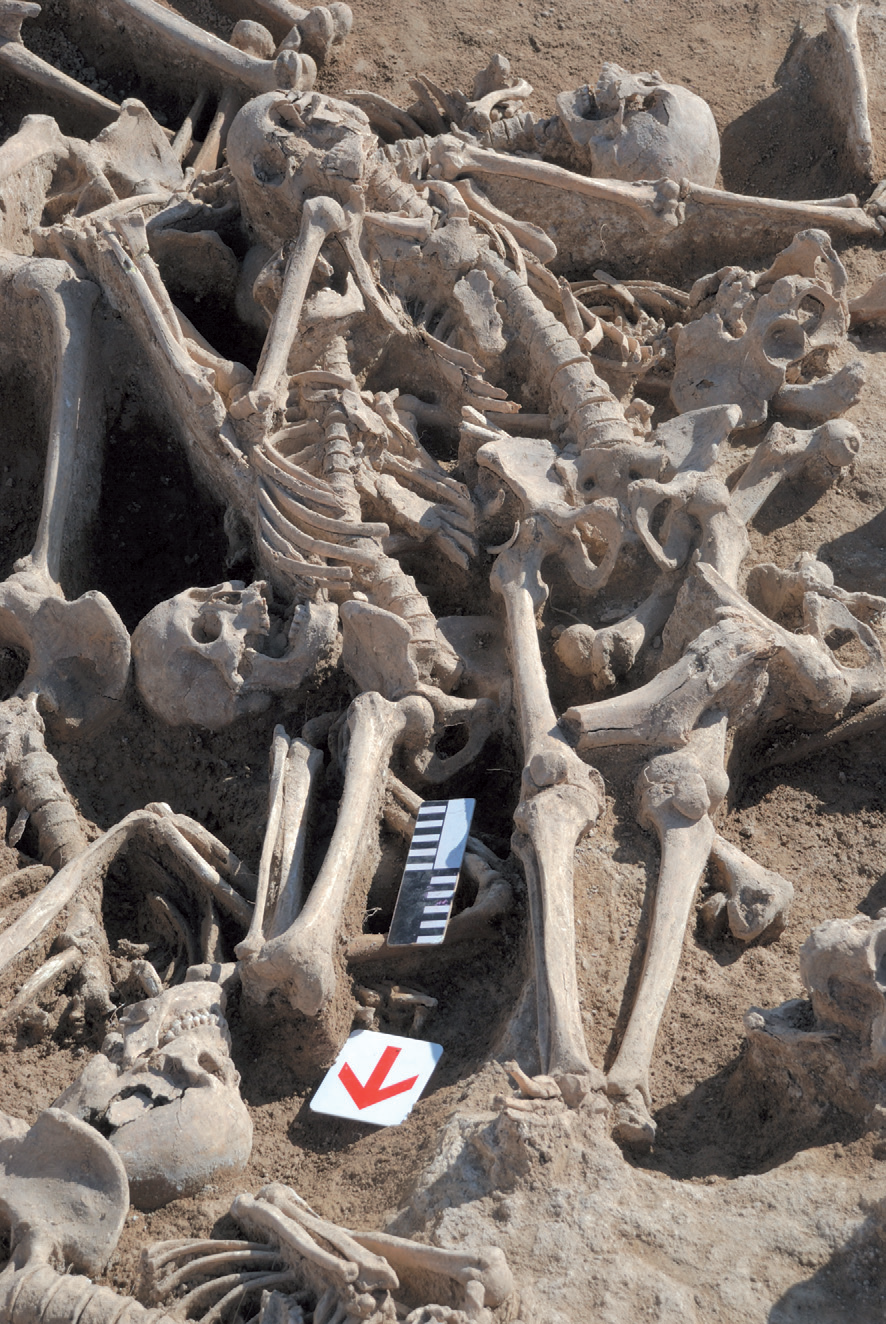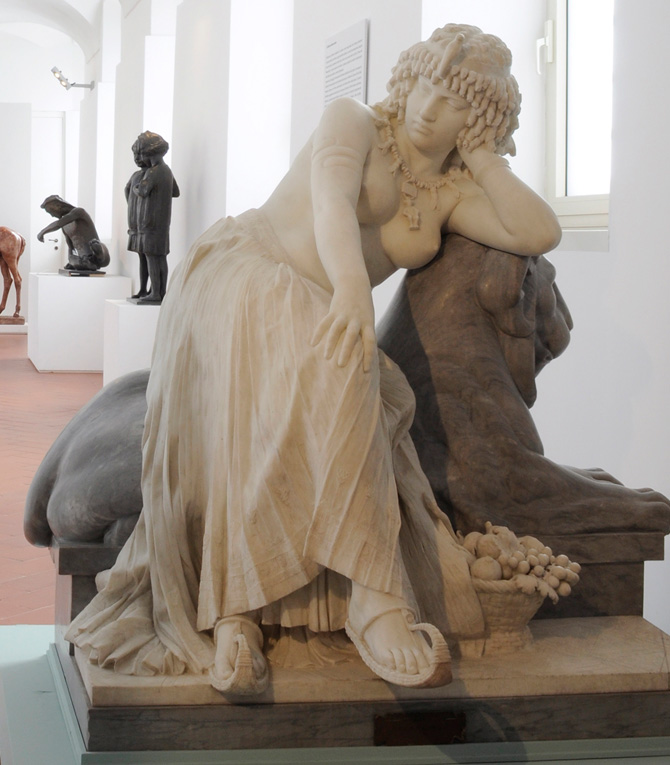A scene from the Han/Xiongnu wars - mass grave at Shouxiangcheng 1st C. BCE
This appears to be a mass grave of Han soldiers at an installation they made inside Xiongnu territory with the purpose of undermining the Xiongnu state through encouraging defection. The Huns took it back and appear to have executed all enemy soldiers via dismemberment.
"The Baian Bulag Fortress as Shouxiangcheng of the Han Empire:
The results of the excavations conducted in 2009 corroborate our proposed conclusion that the Baian Bulag “fortress” is in fact the Han frontier fortress of Shouxiangcheng. Aptly named the “City for receiving submissions”, this fortress, as it is mentioned in the Chinese texts, was an important military base for launching campaigns and diplomatic center for receiving defective Xiongnu groups that would “submit” to the Han imperial court. According to chapter six of the “Han shu”, this fortress had been built outside of the fortified line, under the order of emperor Wudi in 104 BC (Ban Gu 1962, 200). Chapter 110 of the “Shi ji” further reveals that Shouxiangcheng had been built in order to receive the Left Greater Duwei of the Xiongnu, who had been plotting to turn traitor by submitting to the Han and killing the boy chanyu ruler of the Xiongnu. In the spring of 103 BC, Zhao Ponu led Han troops via Shouxiangcheng to unite them with this insurgent Xiongnu leader, but the plot was discovered and foiled by the boy chanyu and his armies, and subsequent attacks against the new Shouxiangcheng were mounted by the Xiongnu (Sima Qian 1959, 2915).
In 81 BC, the chanyu and his troops had taken up a defensive position against Han near Shouxiangcheng (Ban Gu 1962, 3783). This would have been impossible if Shouxiangcheng had been located within territory under Chinese control and thus within “the Guanlu outer fortifications”. In 71 BC, the Chinese undertook a large-scale offensive against the Xiongnu. The plan of this operation revolved around troops under the leadership of the chief censor Tian Guangming which set out from Xihe district and reached Shouxiangcheng (Ban Gu 1962, 3664).
As it is reported in “Han shu”, in 71 BC the ill-fated military leader Tian Guanming had reached Shouxiangcheng and decided not to continue the march. Instead he “indulged in lust” with the widow of a garrison commander who had just passed away, “in the temple where the coffin with the dead husband still stood” (Ban Gu 1962, 3664). Thus, there should be a temple at the site of Shouxiangcheng. The constructions investigated in excavation area 3, covered with tiles that were carried from far away, was most probably built for religious purposes. It seems probable that the illicit sexual act had taken place exactly in this building. Massive walls and fortified pits excavated within area 2 most likely correlate to a fortified armory of the Han garrison, and this completely corresponds with the historical evidence about the character of Shouxiangcheng in the wars with the Xiongnu. A lot of dog bones which were found here show considerable proportion of canine meat in the diet of Chinese soldiers and of the Chinese as a whole at that time (see Peng 1999). Chinese soldiers, whose graves were discovered by our excavations, had evidently been the victims of brutal conflict with the Xiongnu. The terrible picture of executed captive warriors illustrates the ruthless nature of hostilities in the frontier that inspired horror among the Han populace.
At the surface of this cultural layer within pit 1 we found several groups of disarticulated bones, the bodies of adult males. Such a distribution of bones could only be a result of intentional dismemberment of a corpse, after which the parts could have been left on the ground surface where certain bones may have been removed by animals after decomposition of the flesh.
In most cases, the incompleteness of skeletons or separation of body parts cannot be accounted for by decomposition and slowly falling to pieces before the burial. All skeletons and fragments showed indications of intentional dismemberment or cutting of bodies. For example fragment F2 is a right leg with preserved foot. If this leg had been separated due to decomposition, the foot bones would have been the first to fall off. Thus, the leg must have been intentionally cut off before the body had decomposed. Similar observations were made for other fragments: S14 with a right hand had preserved in anatomical order, while there was no left leg; F31, a hand had preserved together with a forearm or F34, a hand had preserved together with an arm. Although the condition of the preserved bones was not good, signs of cutting with a sharp tool, perhaps a sword or dagger could be clearly seen on many of them. Some examples: For skeleton 11 the left part of the face had been smashed, the severed part of the maxilla had been laid on the chest of the deceased, the right hand had been cleft at the metacarpus (Fig. 11,1). The spine of the individual S19 had been broken in the lumbar portion; judging from the signs of cleaving at the vertebrae and the lack of the lower portion of the body, the individual had been cut in half (Fig. 12).
Thus we can assert that the disarticulations of these human bodies were neither from slow decomposition nor from ritual dismemberments but rather are the results of brutal mass killings. Evidence for the severing of individuals while alive can be clearly seen in the position of skeleton S18 (Fig. 11,2). This skeleton lay on his back and his arms had been preserved in raised position in order to shield the face. The forearms had been cut, probably with a single slice; however, the muscles of the deceased had been so strongly cramped that they fixed the posture of arms after death. This could not have happened if the body had been cleft when the individual was already dead. Such posture of arms could have been preserved after a man’s death only due to severe cold, and only if he had not been immediately buried with clay after being killed. It seems most probable that the people buried here had been killed in winter, not far from the fortress, and after the massacre their stiff bodies and severed parts had been gathered and buried at the site of the fort, thus preserving these postures. Two men, S5 and S7 (Fig. 9; 10), lay kneeling with their feet under the pelvis. It may indicate that they were on their knees when they had been killed, which means that the executed people had been captives. Since the “ji”-halberd, the cheek-piece, and the hook, as well as the possible sheath with the bronze buckle, had been put into the grave as funerary goods, we can propose that companions of the deceased, and not any captors of the dead, had buried the fallen. The collection of iron objects, cheek-piece and halberd, imply the category of the dead as most likely being that of mounted troops. Chinese cavalry, particularly, were armed with long “ji”-halberds during the Han period.
The assemblage of iron artifacts unearthed at Baian Bulag, namely the “ji”-halberd, bronzeiron arrowheads, long daggers, hoes, spades, armor plates, the cheek-piece, wheel bushings, and iron cauldrons constitute a fairly complete list of typical Han Chinese iron artifacts and all belong to those types which were mainly usual for the Western Han period (Bai 2005, 163–191; 212–241; 243–244; 249–251). The collection of military equipment and soldiers’ daily goods found at Baian Bulag corresponds with the set of goods from an armory of the Western Han period excavated in the Han imperial capital of Chang’an, which had been the capital of the Han Empire. Crossbow locks, iron “ji”-halberds, bronze and iron handle tips, bronze guards of swords, iron fighting knives, armor plates, a great amount of three-edged arrowheads with iron stems, a bronze caldron, bronze rings and tubes were found there as well (Zhongguo 2005, 80–117). The bronze belt hooks excavated at Baian Bulag also correlate to Western Han style belt hooks unearthed in China (Liu/Ji 2001, 496–497; Fig. 5). As it was mentioned above, the bronze buckle with iron prong excavated in grave 1 is directly analogous to the silver buckle of a sheath for an iron dagger, which was found in tomb 1 in Mancheng, Hebei province (Fig. 21,5.6). Archaeologists were able to identify this as the tomb of the famous Liu Sheng, the first ruler of the Zhongshan kingdom of the Han Empire, and as such it can be precisely dated to 113 BC (Zhongguo/Hebei 1980, 336–337). One of the stamps excavated at Baian Bulag settlement (Fig. 22,5) is directly analogous to a stamp which bears the same inscription of “si yin”, a “private stamp”, and which comes from the Western Han layer of the Xiaohuangdi settlement in Liaoning province (Jilin/Liaoning 1997, 149 Fig. 14,1; Tab. 8,2).
Many of the coins from the excavated areas were poorly preserved and thus their dating is difficult. However, excavation area 2 yielded three “wuzhu” coins which can be dated between the end of the 2nd and the end of the 1st centuries BC (Fig. 22,6–8)18. It is worth noting that no coin from the series produced during the Wang Mang interregnum (8–25 AD) has been found in the excavations or occasional surface findings. Thus the Baian Bulag site should be roughly dated to the first century BC, or, in specific historical terms, from the end of the reign of Han emperor Wudi (141–86 BC) through the reign of Han emperor Chengdi (33–7 BC)."
-The Shouxiangcheng Fortress of the Western Han Period - Excavations at Baian Bulag, Nomgon Sum, Ömnögovi Aimag, Mongolia. Alexei A. Kovalev, Diimaazhav Erdenebaatar, Sergei S. Matrenin, Ivan Iu. Grebennikov. Xiongnu Archaeology - edited by Ursula Brosseder, Bryan K. Miller. 2011 Vor- und Frühgeschichtliche Archäologie Rheinische Friedrich-Wilhelms-Universität Bonn.
 |
| Fig. 9. Baian Bulag. Tomb 1. Skeletons S6–S8, S17, and S18 in situ. |
 |
| Fig. 10. Baian Bulag. Tomb 1. Skeletons S1, S5, S10, and S3 in situ. |
 |
| Fig. 12. Baian Bulag. Tomb 1. View of fracture of spinal column and cut of corpse of skeleton S19. |
Source/Quote:











Comments
Post a Comment